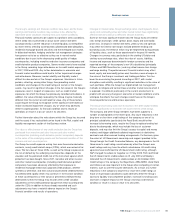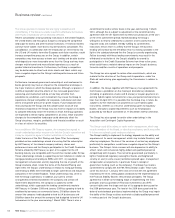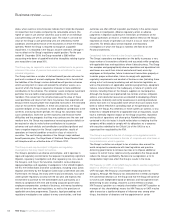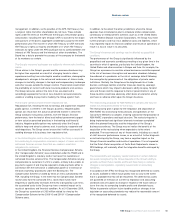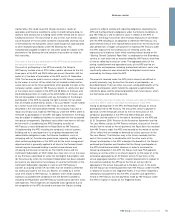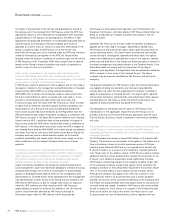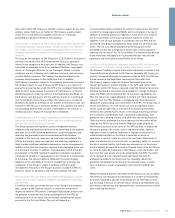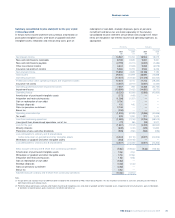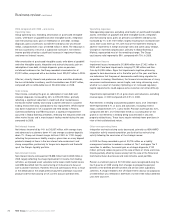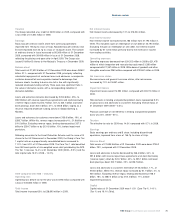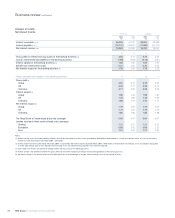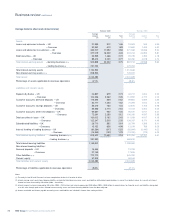RBS 2009 Annual Report Download - page 70
Download and view the complete annual report
Please find page 70 of the 2009 RBS annual report below. You can navigate through the pages in the report by either clicking on the pages listed below, or by using the keyword search tool below to find specific information within the annual report.RBS Group Annual Report and Accounts 200968
Business review continued
efficient procedures to deal with the requirements of the APS and to
training staff, it is not possible to be certain that such actions will be
effective to control each of the operational risks faced by the Group or
to provide the necessary information in the necessary time periods in
the context of the APS. Since the Group’s operational systems were not
originally designed to facilitate compliance with these extensive
continuing obligations, there is a risk that the Group will fail to comply
with a number of these obligations. This risk is particularly acute in the
period immediately following the APS becoming effective. Certain of the
reporting requirements, in particular, are broad in their required scope
and challenging in their required timing. There is, as a result, a real
possibility that the company, at least initially, will not be able to achieve
full compliance. Where the Group is in breach of its continuing
obligations under the Scheme Conditions in respect of any of the
Covered Assets, related assets or other obligations, or otherwise unable
to provide or verify information required under the APS within the
requisite time periods, recovery of losses under the APS may be
adversely impacted, may lead to an indemnity claim and HM Treasury
may in addition have the right to exercise certain step-in rights,
including the right to require the company to appoint a step-in manager
who may exercise oversight, direct management rights and certain other
rights including the right to modify certain of the Group’s strategies,
policies or systems. Therefore, there is a risk that Covered Assets in
relation to which the Group has failed to comply with its continuing
obligations under the Scheme Conditions, will not be protected or fully
protected by the APS. As there is no ability to nominate additional or
alternative assets or exposures for cover under the APS, the effect of
such failures will impact the level of protection available to the Group
and may reduce or eliminate in its entirety the protection anticipated by
the Group for its stressed losses, in which case its business, results of
operations and financial condition will suffer, its credit ratings may drop,
its ability to lend and access funding will be further limited and its cost
of funding may increase. The occurrence of any or all of such events
may cause the price of the securities to decline substantially and may
result in intervention by the Authorities, which could include full
nationalisation or other resolution procedures under the Banking Act.
Any compensation payable to holders of securities would be subject to
the provisions of the Banking Act, and investors may receive no value
for their securities.
The Scheme Conditions may be modified by HM Treasury in certain
prescribed circumstances, which could result in a loss or reduction in the
protection provided under the APS in relation to certain Covered Assets,
increased costs to the Group in respect of the APS or limitations on the
Group’s operations.
HM Treasury may, following consultation with the company, modify or
replace certain of the Scheme Conditions in such a manner as it
considers necessary (acting reasonably) to:
•remove or reduce (or remedy the effects of) any conflict between:
(i) the operation, interpretation or application of certain Scheme
Conditions; and (ii) any of the overarching principles governing the
APS;
•correct any manifest error contained in certain Scheme Conditions;
or
•take account of any change in law.
HM Treasury can only effect a modification or replacement of a Scheme
Condition if (i) it is consistent with each of the Scheme Principles,
(ii) there has been no formal notification from the FSA that such
modification would result in any protection provided to the Royal Bank
under the APS ceasing to satisfy certain requirements for eligible credit
risk mitigation and (iii) HM Treasury has considered in good faith and
had regard to any submissions, communications or representations of
or made by the Royal Bank regarding the anticipated impact of the
proposed modification under any non-UK capital adequacy regime
which is binding on the Royal Bank or a Covered Entity.
Such modifications or replacements may be retrospective and may
result in a loss of or reduction in the protection expected by the Group
under the APS in relation to certain Covered Assets, an increase in the
risk weightings of the Covered Assets (either in the UK or overseas), a
material increase in the continuing reporting obligations or asset
management conditions applicable to the Group under the Scheme
Conditions or a material increase in the expenses incurred or costs
payable by the Royal Bank under the APS. Modifications by
HM Treasury of the Scheme Conditions could result in restrictions or
limitations on the Group’s operations. The consequences of any such
modifications by HM Treasury are impossible to quantify and are difficult
to predict and may have a material adverse effect on the Group’s
financial condition and results of operations.
Owing to the complexity of the APS and possible regulatory capital
developments, the operation of the APS and the issue of £25.5 billion of
B shares and, if required, the £8 billion Contingent B shares may fail to
achieve the desired effect on the Group’s regulatory capital position. This
may mean the Group’s participation in the APS and the issuance of
£25.5 billion of B shares and, if required, the £8 billion Contingent B
shares does not improve market confidence in the Group sufficiently or
at all. This may result in the Group facing the risk of full nationalisation
or other resolution procedures under the Banking Act.
One of the key objectives of the APS and the recent issuance of
£25.5 billion of B shares and, if required, the £8 billion Contingent B
shares was to improve capital ratios at a consolidated level for the
Group and at an individual level for certain relevant Group members.
The Royal Bank will or may in the future enter into certain back-to-back
arrangements with Group members holding assets or exposures to be
covered by the APS in order to ensure the capital ratios of these entities
are also improved by virtue of the APS. As the APS and certain of the
associated back-to-back arrangements are a unique form of credit
protection over a complex range of diversified Covered Assets in a
number of jurisdictions, there is a risk that the interpretation of the
relevant regulatory capital requirements by one or more of the relevant
regulatory authorities may differ from that assumed by the Group, with
the result that the anticipated improvement to the Group’s capital ratios
will not be fully achieved. There is a further risk that, given that the
current regulatory capital requirements and the regulatory bodies
governing these requirements are subject to unprecedented levels of
review and scrutiny both globally and locally, regulatory capital
treatment that differs from that assumed by the Group in respect of the
APS, the treatment of the B share issuance or the back-to-back
arrangement may also occur because of changes in law or regulation,
regulatory bodies or interpretation of the regulatory capital regimes
applicable to the Group and/or the APS and/or the B shares and/or the
back-to-back arrangements described above. If participation in the APS
and the issuance of £25.5 billion of B shares and, if required, the
£8 billion Contingent B shares are not sufficient to maintain the Group’s



